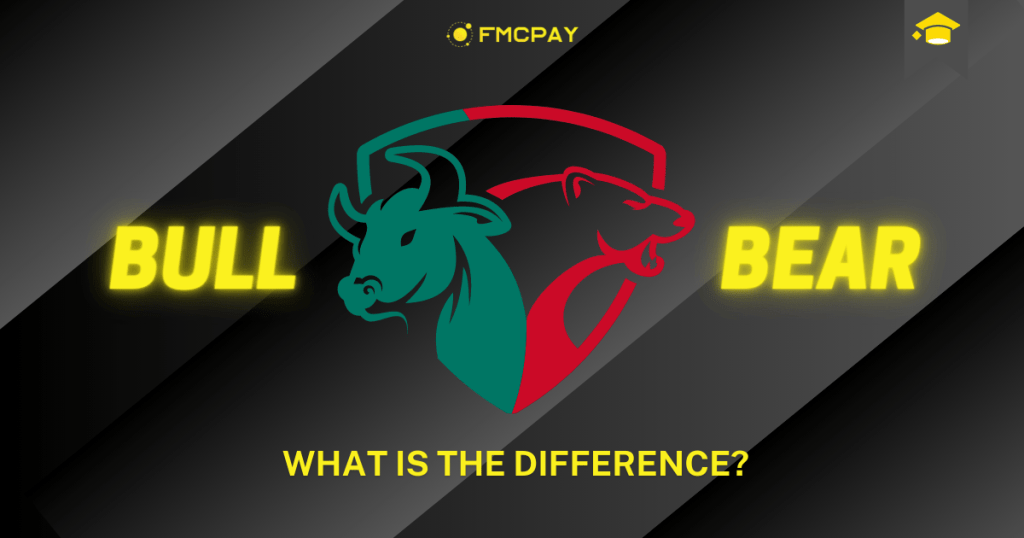Bull Market and Bear Market are two common terms in the crypto industry that refer to two market ups/downs.
Understanding the Bull and Bear markets helps you have a more sensitive view of the market, have more bases to predict the next market trend, and make more effective investment decisions
What is the Bull market?
A bull market definition is that prices are rising and investors expect that to continue. In this period, most investors tend to buy instead of sell.
Demand is greater than supply. Market confidence is high and asset prices are growing strongly. Optimistic green color covered the market, and good news spread everywhere.
What is the Bear market?
When prices fall for an extended time and are expected to continue dropping, that’s a bear market. In these cases, the old saying is that every rally looks like a selling opportunity.
A Bear Market is a period in which the majority of investors are selling. Supply is greater than demand, forcing selling pressure to make the market red. The majority of investors lost confidence in the market. They are pessimistic and believe that prices will continue to fall. The Bear Market is quite difficult to trade compared to the Bull Market, especially for less experienced traders.
Differences between the bull market and bear market
Bull market
- Investors are optimistic, or bullish, about stock prices.
- Stocks rally even when there’s negative news about the economy or a particular stock.
- The rise is broad-based, and most stocks gain, even if a company is doing poorly.
- Company earnings are growing as a whole.
- The economy is doing well. Measures for this include quarterly gross domestic product (GDP) growth and a falling unemployment rate.
- Interest rates aren’t rising in a way that’s seen as threatening to the market rally.
Bear market
- Investors are pessimistic, or bearish, on stock prices.
- Stock prices ignore positive news about the economy or a certain stock.
- The sell-off is broad-based and most stocks fall, even if a company is doing well.
- Interest rates may be rising.
- Corporate earnings are contracting.
- The broader economy is weak or struggling.
What Makes a Market Bull or Bear?
Several aspects, such as supply and demand, change in economic activities, and investors’ psychology affect the market – whether it goes bull or bear.
1. Supply and demand
Bull and bear markets are partly a result of the supply and demand for securities. The bull market is characterized by strong demand and weak supply for securities.
Many investors wish to buy securities while few are willing to sell. As a result, share prices rise. On the contrary, in a bear market, the demand is significantly lower than supply as more people are looking to sell than buy. As a result, share prices drop.
The ideal thing for an investor to do during the bull market is to buy stocks early in the trend, watch them rise in value, and sell them when they reach their peak.
However, in a bear market, when the probability of losses is greater, and there seems to be no end in sight, investors can profit from short-selling, buying inverse ETFs or put options, or turning to safer investments, such as fixed-income securities.
2. Changes in economic activities
Another factor that determines whether the market is bull or bear is how the economy changes from time to time. In a bull market, corporate earnings increase, and the economy grows as consumers tend to spend more due to the wealth effect. Trading and IPO activity also increases during the bull run.
On the opposite, in a bear market, consumers tend to set stricter priorities and reduce their spending, leading to lower sales and a fall in business profits. This, in turn, affects the way the market values stock and leads to a negative impact on GDP.
3. Investors’ psychology
Investors’ psychology and stock market performance are also mutually dependent. In a bull market, the increase in stock market prices boosts investor confidence, which causes investors to put their money in the market in the hope of obtaining a profit.
However, in a bearish phase, the sentiment is negative, and investors begin to move their money out of equities and into fixed-income securities, waiting for a positive move in the stock market.
Conclusion
In conclusion, bull or bear markets are two opposing trends that affect the financial markets, which have a significant impact on investment decisions and investors’ psychology. While a bull market is generally seen as more favorable for investors, it’s important to note that market fluctuations are a normal part of the investment cycle, and both trends offer opportunities for investors to capitalize on. Therefore, investors should follow the market trend frequently in order to make accurate decisions, increase profit and cut down losses.

